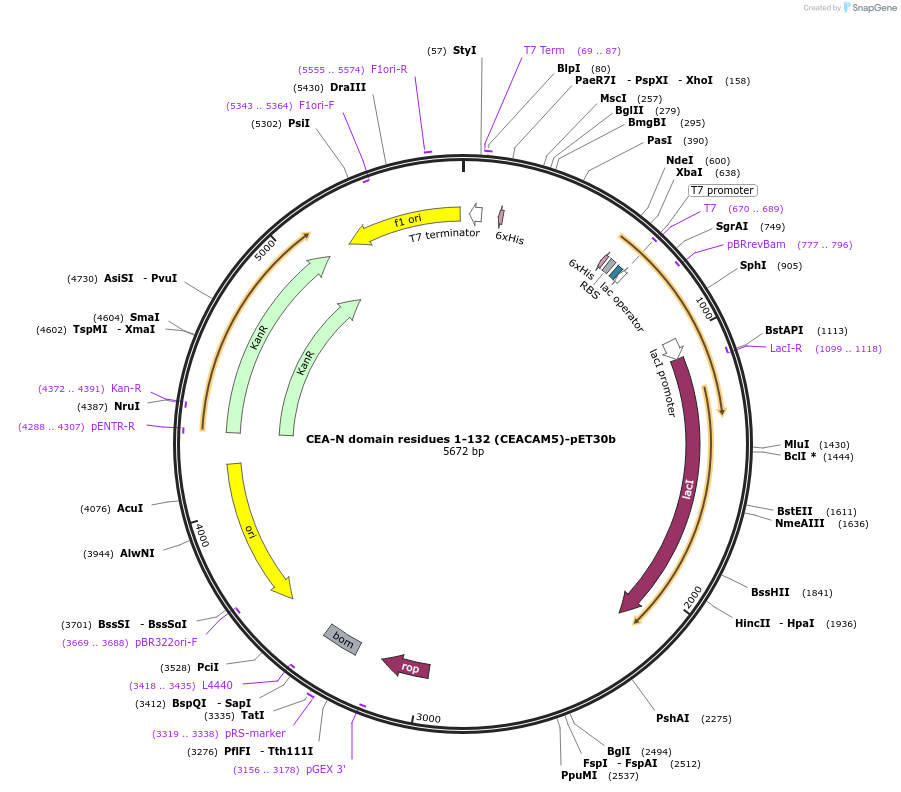CEA-N domain residues 1-132 (CEACAM5)-pET30b
(Plasmid
#174693)
-
PurposePlasmid expressing CEA-N domain
-
Depositing Lab
-
Sequence Information
Ordering
| Item | Catalog # | Description | Quantity | Price (USD) | |
|---|---|---|---|---|---|
| Plasmid | 174693 | Standard format: Plasmid sent in bacteria as agar stab | 1 | $89 | |
Backbone
-
Vector backbonepET30B+
-
Backbone manufacturerNovagen EMD Milipore
- Backbone size w/o insert (bp) 5421
-
Vector typeBacterial Expression
Growth in Bacteria
-
Bacterial Resistance(s)Kanamycin, 50 μg/mL
-
Growth Temperature37°C
-
Growth Strain(s)DH5alpha
-
Growth instructionsThe depositing lab recommends BL21(DE3) cells for bacterial expression.
-
Copy numberHigh Copy
Gene/Insert
-
Gene/Insert nameCEA-N Domain
-
Alt nameCEA-N domain cloned form CEA CEACAM5 transcript variant 3, mRNA, residues 1 to 132
-
SpeciesH. sapiens (human)
-
Insert Size (bp)446
-
Mutationnone
- Promoter T7 Promoter
-
Tag
/ Fusion Protein
- TEV Cleavage Site and hexahistidine (HIS) tag (N terminal on backbone)
Cloning Information
- Cloning method Restriction Enzyme
- 5′ cloning site NdeI (not destroyed)
- 3′ cloning site XhoI (not destroyed)
- 5′ sequencing primer T7 Promoter
- 3′ sequencing primer T7 Terminator
- (Common Sequencing Primers)
Terms and Licenses
-
Academic/Nonprofit Terms
-
Industry Terms
- Not Available to Industry
Trademarks:
- Zeocin® is an InvivoGen trademark.
These plasmids were created by your colleagues. Please acknowledge the Principal Investigator, cite the article in which the plasmids were described, and include Addgene in the Materials and Methods of your future publications.
-
For your Materials & Methods section:
CEA-N domain residues 1-132 (CEACAM5)-pET30b was a gift from Jean Gariepy (Addgene plasmid # 174693 ; http://n2t.net/addgene:174693 ; RRID:Addgene_174693) -
For your References section:
Induction of antigen-specific TH 9 immunity accompanied by mast cell activation blocks tumor cell engraftment. Abdul-Wahid A, Cydzik M, Prodeus A, Alwash M, Stanojcic M, Thompson M, Huang EH, Shively JE, Gray-Owen SD, Gariepy J. Int J Cancer. 2016 Aug 15;139(4):841-53. doi: 10.1002/ijc.30121. Epub 2016 Apr 15. 10.1002/ijc.30121 PubMed 27037842



